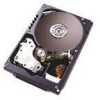IBM IC35L036UWDY10 Hard Drive Specifications - Page 44
Jumper signal description on J4, 2.2.3 Position #5-6 on J4: Force SE mode
 |
UPC - 000004119524
View all IBM IC35L036UWDY10 manuals
Add to My Manuals
Save this manual to your list of manuals |
Page 44 highlights
7.2.1.3 Position #7-8: Disable SCSI Parity Check Installing a jumper disables SCSI Parity checking. 7.2.1.4 Position #9-10: Enable TI-SDTR Installing a jumper enables Target Initiated Synchronous Data Transfer Request (SDTR) and Wide Data Transfer Request (WDTR) negotiation. If this jumper is not installed, SSM (Synchronous select Mode) bit in Mode Page 0 controls Target Initiated SDTR and WDTR negotiation. If this jumper is installed, SSM bit is ignored. 7.2.1.5 Position #11-12: Disable Unit Attention Installing a jumper enables control of UAI (Unit Attention Inhibit) bit in Mode Page 0. 7.2.1.6 Position #13-14 Reserved. 7.2.2 Jumper signal description on J4 7.2.2.1 Position #1-2: LED pins The LED pins are used to drive an external Light Emitting Diode. Up to 30 mA of sink current capability is provided. The LED Anode must be tied to the current limited + 5 V source provided on the pin for LED Anode at the Location #1 on J4 jumper block. The LED Cathode is then connected to the pin for LED Cathode at the Location #2 on J4 jumper block to complete the circuit. 68pin +5V 150 Ohms Positions #1,#2 on J-4 Jumper Block (pin 1 of J-4) to LED Anode (pin2 of J-4) to LED Cathode 150 Ohms pin 8 of AUX connector 80pin +5V +5V 620 Ohms 150 Ohms (on board) LED Positions #1,#2 on J-4 Jumper Block (pin 1 of J-4) to LED Anode (pin2 of J-4) to LED Cathode pin 77 of 80pin connector 0 Ohms Figure 24. LED circuit 7.2.2.2 Position #3-4 on J4: Term Power Not connected for 80-pin models. If a jumper is installed on 68-pin models, termination power is supplied to pins 17, 18, 51, and 52 of the 68-pin SCSI interface. 7.2.2.3 Position #5-6 on J4: Force SE mode If a jumper is installed, the drive functions as a single-ended mode drive. Ultrastar 146Z10 hard disk drive specifications 28















